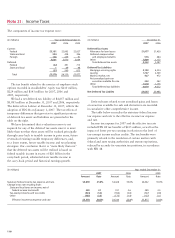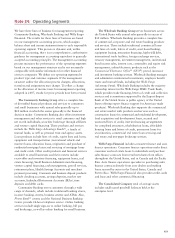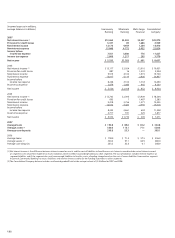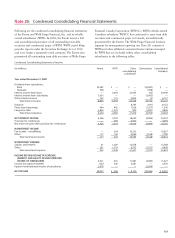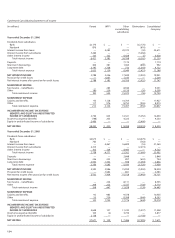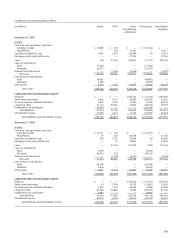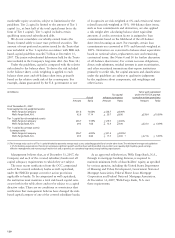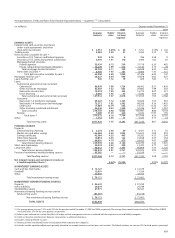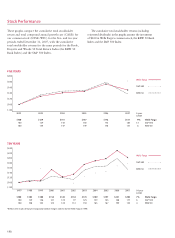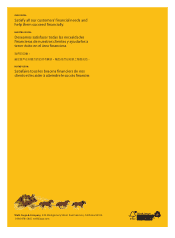Wells Fargo 2007 Annual Report Download - page 131
Download and view the complete annual report
Please find page 131 of the 2007 Wells Fargo annual report below. You can navigate through the pages in the report by either clicking on the pages listed below, or by using the keyword search tool below to find specific information within the annual report.
128
marketable equity securities, subject to limitations by the
guidelines. Tier 2 capital is limited to the amount of Tier 1
capital (i.e., at least half of the total capital must be in the
form of Tier 1 capital). Tier 3 capital includes certain
qualifying unsecured subordinated debt.
We do not consolidate our wholly-owned trusts (the
Trusts) formed solely to issue trust preferred securities. The
amount of trust preferred securities issued by the Trusts that
was includable in Tier 1 capital in accordance with FRB risk-
based capital guidelines was $4.7 billion at December 31,
2007. The junior subordinated debentures held by the Trusts
were included in the Company’s long-term debt. (See Note 14.)
Under the guidelines, capital is compared with the relative
risk related to the balance sheet. To derive the risk included
in the balance sheet, a risk weighting is applied to each
balance sheet asset and off-balance sheet item, primarily
based on the relative credit risk of the counterparty. For
example, claims guaranteed by the U.S. government or one
of its agencies are risk-weighted at 0% and certain real estate
related loans risk-weighted at 50%. Off-balance sheet items,
such as loan commitments and derivatives, are also applied
a risk weight after calculating balance sheet equivalent
amounts. A credit conversion factor is assigned to loan
commitments based on the likelihood of the off-balance
sheet item becoming an asset. For example, certain loan
commitments are converted at 50% and then risk-weighted at
100%. Derivatives are converted to balance sheet equivalents
based on notional values, replacement costs and remaining
contractual terms. (See Notes 6 and 16 for further discussion
of off-balance sheet items.) For certain recourse obligations,
direct credit substitutes, residual interests in asset securitization,
and other securitized transactions that expose institutions
primarily to credit risk, the capital amounts and classification
under the guidelines are subject to qualitative judgments
by the regulators about components, risk weightings and
other factors.
(in billions) To be well capitalized
For capital under the FDICIA prompt
Actual adequacy purposes corrective action provisions
Amount Ratio Amount Ratio Amount Ratio
As of December 31, 2007:
Total capital (to risk-weighted assets)
Wells Fargo & Company $51.6 10.68% >$38.7 >8.00%
Wells Fargo Bank, N.A. 42.8 11.14 > 30.7 >8.00 >$38.4 >10.00%
Tier 1 capital (to risk-weighted assets)
Wells Fargo & Company $36.7 7.59% > $19.3 >4.00%
Wells Fargo Bank, N.A. 29.5 7.68 > 15.4 >4.00 >$23.0 > 6.00%
Tier 1 capital (to average assets)
(Leverage ratio)
Wells Fargo & Company $36.7 6.83% > $21.5 >4.00%
(1)
Wells Fargo Bank, N.A. 29.5 6.84 > 17.3 >4.00
(1)
>$21.6 > 5.00%
(1) The leverage ratio consists of Tier 1 capital divided by quarterly average total assets, excluding goodwill and certain other items. The minimum leverage ratio guideline
is 3% for banking organizations that do not anticipate significant growth and that have well-diversified risk, excellent asset quality, high liquidity, good earnings,
effective management and monitoring of market risk and, in general, are considered top-rated, strong banking organizations.
Management believes that, as of December 31, 2007, the
Company and each of the covered subsidiary banks met all
capital adequacy requirements to which they are subject.
The most recent notification from the OCC categorized
each of the covered subsidiary banks as well capitalized,
under the FDICIA prompt corrective action provisions
applicable to banks. To be categorized as well capitalized,
the institution must maintain a total risk-based capital ratio
as set forth in the table above and not be subject to a capital
directive order. There are no conditions or events since that
notification that management believes have changed the risk-
based capital category of any of the covered subsidiary banks.
As an approved seller/servicer, Wells Fargo Bank, N.A.,
through its mortgage banking division, is required to
maintain minimum levels of shareholders’ equity, as specified
by various agencies, including the United States Department
of Housing and Urban Development, Government National
Mortgage Association, Federal Home Loan Mortgage
Corporation and Federal National Mortgage Association.
At December 31, 2007, Wells Fargo Bank, N.A. met
these requirements.


